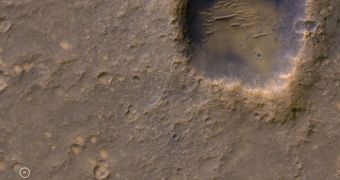Experts operating the Mars Reconnaissance Orbiter (MRO) announce that the orbiter was recently able to observe two defunct Martian missions from its orbital perch. The Mars Exploration Rover Spirit and the Phoenix Mars Lander completed both of their missions successfully.
Spirit, or MER-A, has been inactive since 2010, when mission controllers at the NASA Jet Propulsion Laboratory (JPL), in Pasadena, California, finally decided to shut it down. The robot was trapped in a patch of loose sand called Troy, and all maneuvers meant to remove it had failed.
However, the machine did exceed its planned operation schedule tens of times over. When it landed on Mars, in January, 2004, its mission was to survey our neighboring planet for just three months. But it managed to endure for nearly 7 years.
In the new image relayed by the MRO, investigators did not see Spirit itself, but rather the three-petal landing platform that delivered it safely to the planetary surface. The object was imaged using the orbiter's High Resolution Imaging Science Experiment (HiRISE) instrument.
HiRISE was also used to image the grave of the Phoenix Mars Lander, a spacecraft that set down on the planet's surface in 2008. It is largely credited with discovering solid evidence that huge amounts of water ice still exist at the Martian poles, just buried under a thin layer of sand.
The latest image the MRO collected of Phoenix was snapped on January 26, 2012. It shows how the lander looks like after enduring its second winter on the Red Planet. The first was enough to damage it beyond repair, but the new one is bound to have caused even more damage.
The mission was discontinued in November 2008 (Phoenix arrived in May), after decreasing sunlight levels, dust swirls and extremely low temperatures finally managed to cripple the three-legged, $475-million spacecraft.
This is not the first time the MRO is used to support other missions. In the past, when both Spirit and Phoenix were active, the orbiter was used to relay signals back to NASA Mission Control. This was possible because it always benefited from the same amount of sunlight.
During the winters it spent on Mars, Spirit never had any excess power, and relaying a message to Earth via its high-gain antenna would have been the equivalent of waiting for a few days until its batteries were recharged.
By using the low-gain antenna to contact the MRO, and allowing the orbiter to contact Earth, the rover saved up a lot of energy, which it then went on to use for scientific and practical applications, Space reports.
The MRO itself is operating on an extended mission. It achieved orbital insertion around Mars on March 10, 2006 and has been analyzing our neighboring planet ever since. It is single-handedly responsible for most of the highest-resolution maps we have of the Martian surface.

 14 DAY TRIAL //
14 DAY TRIAL //